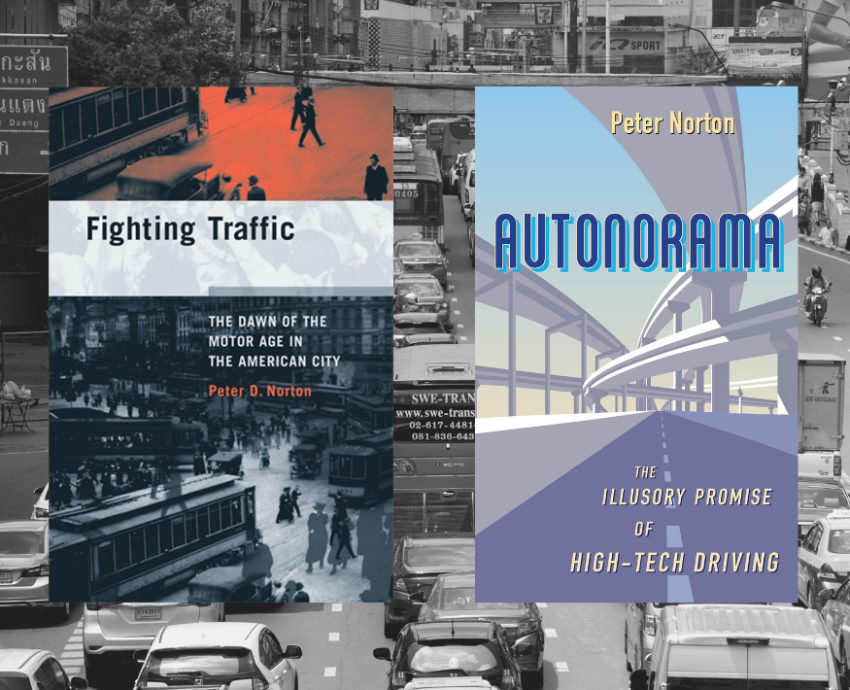
Autonorama
By Peter Norton
Island Press, 2021
Fighting Traffic: The Dawn of the Motor Age in the American City
By Peter Norton
MIT Press, 2011
Before the invention of the automobile, streets were seen as public spaces with a variety of uses and users, pedestrians and children at play among them.
In Fighting Traffic, Peter Norton, associate professor of history at the University of Virginia, takes us back to the period from 1910 to 1930, when this all changed.
This period saw waves of carnage on the streets when tens of thousands of people died every year in automobile collisions. Civil groups sprung up to restore safety and strictly limit the cars' invasion of urban streets. Public mournings were held in many cities attracting huge crowds of children and parents. Prominent monuments were erected to crash victims.
Efficient and popular tram systems became stuck behind private cars. Downtown businesses were increasingly concerned about the resulting drop in foot traffic and use of kerbside space for parked cars. Downtown parking bans were implemented in many cities and were found to increase trade.
It was widely accepted that speed came at the expense of safety. In Cincinnati, 42,000 people signed a petition requiring all cars in the city to be fitted with "speed governors" that would mechanically limit top speeds to 40 km/h. The movement was defeated in the end when automotive interests (referred to as "motordom") banded together and used their financial clout to run campaigns masquerading as grassroots citizens groups.
Motordom also used sophisticated public relations campaigns to shift the burden of responsibility for safety onto pedestrians. Framing deaths as "accidents" due to carelessness, they invented the concept of “jaywalking”. “Jay” was previously a negative term meaning roughly “hillbilly”, “hick”, or in Australian slang, “bogan”.
The politics of the time were also changing. The Progressive Era prior to the 1920s saw the street as a public service subject to positive regulation in the public interest, similar to water, gas, telephones and railways. Automobiles, the most spatially inefficient mode of transport, had to be controlled. The Roaring Twenties, in contrast, felt the rising influence of industry groups and found their champion in future United States president Herbert Hoover who favoured deregulation.
A slump in car sales in 1923‒24 worried industry leaders. Some traffic experts suggested that “peak car” had arrived due to the self-limiting nature of congestion and hence the usefulness of cars in urban areas. Motordom eventually managed to reframe the problem as a lack of road space, promoting road widenings and an extensive interstate highway system, despite the massive expense involved. They knew that more roads meant more driving, and more car sales.
In Autonorama, Norton picks up the story towards the end of the 1930s when US road deaths were surging. The focus this time though is on the various hyped-up marketing campaigns that have recurred roughly once a generation to maintain the illusory promise of safe, congestion-free, environmentally-friendly driving.
General Motors' “Futurama” exhibit at the 1939 New York World's Fair was a giant amusement ride designed to stimulate the use and sale of cars. Twenty-five thousand visitors a day rode in moving chairs over an animated diorama containing millions of miniature trees, buildings and, of course, cars.
People queued for hours to witness this utopian vision of the congestion-free automotive future. The model cars just looped around endlessly and parking lots were nowhere to be seen. As visitors left the exhibit, they received a badge with the slogan “I have seen the future”. It was all the brainchild of set designers and advertising executives.
“Futurama 2” came along 25 years later at the 1964 New York World's fair and was seen by 70,000 people a day.
The idea was to provide a techno-scientific vision close enough in the future to seem plausible but far-off enough so that if it never eventuated few would remember the details or feel duped. As long as it distracted the populace and decision-makers from practical, efficient and affordable alternatives that were already available, the Futuramas and their descendants served their true purpose.
Norton goes on to argue that the current hype around "autonomous" vehicles are part of the same trick. The technology is much further off than usually claimed, with the profit motive meaning safety will continue to be traded off against the desire for speed and a smooth passenger experience. Other negative effects include increased urban sprawl and transport volumes as well as higher energy demand.
Autonorama is a powerful critique of technological “solutionism”, the idea that instead of humans framing a problem and deciding what tools are needed to solve it, technology somehow magically determines the direction we all must follow.
Norton's meticulous historical research is immensely valuable. We can see that our cities change for better or worse not just through technological invention, but also through deliberate efforts in policy, and to influence social norms. By taking us back through a century of mistakes we are better able to rewind the tape and avoid making them again.